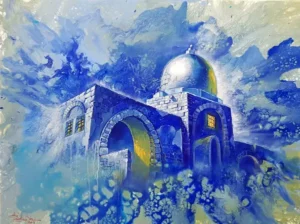In this sicha we see how important is the concept of transforming exile (gola) to Redemption (Geuloh). The Rebbe brings out that we are not fighting the exile (gola) but rather transforming it as it is in its essence by inserting and revealing the Alef — the recognition of G-d’s presence. In other words, the Rebbe is explaining that the Geuloh, which is ready to occur at any moment, is dependent upon our active recognition that everything is from Hashem…
These correspond to the three levels (three different ways of explaining the “alef”) which the Rebbe speaks about in this sicha:
- The Master of the World (Alufo shel olam): G-dliness as it is found in the world;
- Being imbued with wisdom (a’alfa chochma): referring to the Torah, which is higher than the world but somewhat related to the world;
- Wonder (peleh): the letters alef, lamed, pay (which spell “alef“, and can be re-arranged to spell “peleh“, meaning “wonder”) refers to the level of G-dliness which completely transcends the world.
In the Rebbe’s words:
This represents the progression of G-dly revelation leading to the days of Moshiach: 1) G-dliness within the world, 2) G-dliness higher than, but still connected with the world, and 3) the revelation of G-d’s essence. Our service of G-d in golus (which consists of bringing the Alef into golah to bring the Geuloh) must correspond to these three levels. And through this we bring about these kinds of G-dly revelation alluded to by the letter Alef.
This means that we must reveal the presence of G-dliness within the world by using all physical objects for a holy purpose — “for the sake of Heaven” (to correspond to the level of G-dliness within the world). Furthermore, we must bring down and reveal the second level through learning Torah, and reveal the third level of peleh by learning Pnimiyus HaTorah, Chassidus, which corresponds to the level of peleh in Torah.
We can extend this idea further: in addition to the revelation of the level of peleh through the study of Chassidus, it is revealed through the very exile itself. The prophet Yeshayahu said (12:1), “On that day [(of redemption] you will say, ‘I thank you G-d for having been angry with me.’ ” This verse seems somewhat puzzling. Granted that we will be thankful for G-d’s nullification of exile — but this expression of appreciation would not really be wholehearted. One would praise G-d even more completely if there had been no exile to begin with!
In light of the above this can be easily understood. Redemption comes about from and is composed of the very exile itself. We are therefore thanking Him deeply for the exile since we realize that it has brought the highest revelations, including that corresponding to the level of peleh…
All this contains straightforward guidance in what all Jews should be doing to further hasten the redemption — in all three levels alluded to by the letter alef. This means first of all revealing G-d’s presence in the world through using all worldly objects for a holy purpose, etc. In addition, there must be a special increase in Torah study — and particularly the study of Chassidus — in a way that it should be clearly understood in Chochmah, Binah, and Da’as. Included in this is also influencing others to follow suit…
DISCLAIMER
The above excerpts/quotes are provided by Emor precisely as they appear in the original source, without any modifications or corrections to typos. Text within square brackets, as well as subtitles and bold formatting, are added by Emor for emphasis, clarification, or commentary, and the original content has not been changed.

